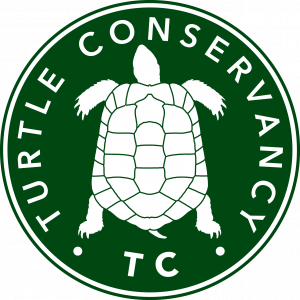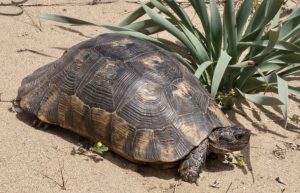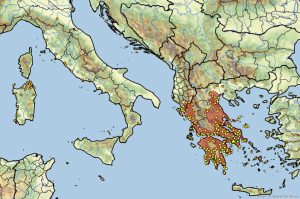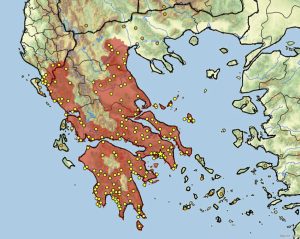Testudo marginata, 122
Testudo marginata Schoepff 1793 –
Marginated Tortoise,
Kraspedochelóna, Breshka Malore, Testuggine Marginata
Daniel Escoriza1, Elias Tzoras2, and Henrik Bringsøe3
1Grup de Recerca en Ecologia Aquàtica Continental (GRECO),
University of Girona, Campus Montilivi, 17071 Girona, Spain [[email protected]];
2Patras, 26442 Achaia, Greece [[email protected]];
3Irisvej 8, 4600 Køge, Denmark [[email protected]]
Summary. — The Marginated Tortoise, Testudo marginata (family Testudinidae), is a medium-sized tortoise and largest member of its genus (straightline carapace lengths [SCL] usually up to 40 cm, exceptionally to 47.5 cm), native to Greece and southern Albania, and introduced historically to northeastern Sardinia. The species is entirely restricted to regions with a warm, scorched-dry to sub-humid Mediterranean climate, at low to moderate altitudes (up to 1600 m in southern Greece and 600 m in Sardinia). Morphologically, T. marginata differs from other Mediterranean Testudo species by the combination of chevron markings arranged symmetrically along the longitudinal axis of the plastron, overall dark carapace coloration, and laterally elongated and pronounced flaring of the posterior marginals (less marked in populations from the Peloponnese Mani peninsula and Sardinia). The size of males is roughly similar to that of females, although sometimes slightly larger (male mean SCL = 30.2 cm, female mean SCL = 28.0 cm; for the smaller southern Peloponnese (weissingeri) ecotype, male mean SCL = 21.3 cm, female mean SCL = 20.9 cm). Mating occurs primarily in September–October and to a lesser extent in April–May. Females nest in May–June and produce up to 3 clutches of 4–9 (rarely up to 15) eggs. Hatchlings have an SCL of 30–40 mm. The main threat to T. marginata within its natural range is habitat alteration and loss from intensive agriculture and expanding development, including construction of tourist facilities, but many populations are still relatively robust.
Distribution. — Greece and Albania. The species is widespread in central mainland Greece and the Peloponnese peninsula, as well as extreme southern Albania. Native populations also occur on several islands in the Ionian and Aegean seas: Alonissos, Dokos, Elafonisos, Evvia, Kastos, Kyra Panagia, Kythera, Petalas, Poros, Psili, Romvi, Salamina, Sapientza, Sfaktiria, Skiathos, Skyros, Spetses, Spetsopoula, Trizonia, and Valaxa. Viable introduced populations occur on the Aegean islands of Chios and Lesvos. The species previously occurred on Crete, Kos, and Tilos during the Pleistocene and earlier Holocene, but was extirpated from these islands long ago. It was introduced in historical times to northern Sardinia (Italy) and some of its satellite islands. Apparently translocated or introduced specimens and/or populations also occur elsewhere on Sardinia and in continental Italy, as well as on various Ionian and Aegean islands.
Synonymy. — Testudo marginata Schoepff 1793, Testudo graja Hermann in Schoepff 1793, Testudo graja Hermann 1804, Testudo campanulata Walbaum in Strauch 1862, Peltastes marginatus melas Gray 1870, Testudo nemoralis Schreiber 1875, Testudo marginata cretensis † Bachmayer, Brinkerink and Symeonidis 1975, Testudo marginata sarda Mayer 1992, Testudo marginata weissingeri Trutnau 1994, Testudo weissingeri Bour 1996.
Subspecies. — No subspecies are currently recognized.
Status. — IUCN 2022 Red List: Least Concern (LC, assessed 2004); CITES: Appendix II; EU: Annex A (regulation of trade of fauna and flora); EU Habitats Directive: Annexes II and IV (conservation of natural habitats and of wild fauna and flora); Bern Convention: Annex II; Greece: Least Concern (LC); Albania: Least Concern (LC); Italy: Red List, Near Threatened (NT, assessed 2013).
Citation:
Escoriza, D., Tzoras, E., and Bringsøe, H. 2023. Testudo marginata Schoepff 1793 – Marginated Tortoise, Kraspedochelóna, Breshka Malore, Testuggine Marginata. In: Rhodin, A.G.J., Iverson, J.B., van Dijk, P.P., Stanford, C.B., Goode, E.V., Buhlmann, K.A., and Mittermeier, R.A. (Eds.). Conservation Biology of Freshwater Turtles and Tortoises: A Compilation Project of the IUCN/SSC Tortoise and Freshwater Turtle Specialist Group. Chelonian Research Monographs 5(17):122.1–25. doi: 10.3854/crm.5.122.marginata.v1.2023; www.iucn-tftsg.org/cbftt/.
Adobe Acrobat 6.0 or later required)
Adult Testudo marginata from the coastal dunes at Strofylia National Park, northwestern Peloponnese peninsula, Greece.
Photo by Henrik Bringsøe.
Distribution:
Distribution of Testudo marginata in the wider Mediterranean region (top) and in Albania and Greece (bottom). Yellow dots = museum and literature occurrence records of native populations based on Iverson (1992), other more recent literature records (see TTWG 2021), and authors’ additional data; orange dots = introduced or possibly historically relict populations or individual trade or translocated specimens; yellow star = restricted estimated type locality. Distribution based on fine-scaled GIS-defined level 12 HUCs (hydrologic unit compartments) constructed around verified localities and then adding HUCs that connect known point localities in the same watershed or physiographic region, and similar habitats and elevations as verified HUCs based on Buhlmann et al. (2009), TTWG (2017, 2021), and data from authors and other sources.











